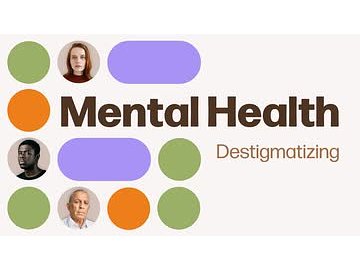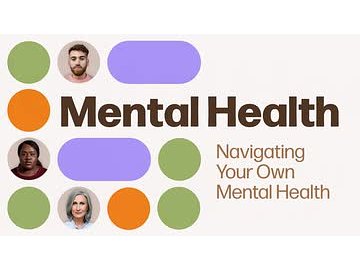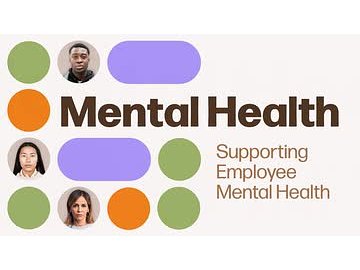Remote Employee Mental Health: Maintaining the Mental Health of Your Remote Employees
The more we get to know about the stresses of remote work, the more we understand that it can take a toll on your mental health. Your remote workers may hide that they're struggling mentally, but surveys show many of them are. Whether it has to do with a diagnosed mental health disorder, or simply someone being lonely while working from home, mental health among remote workers is something we as leaders should take seriously. In this course, we'll address how you can take action to improve and maintain the mental health of your remote employees. We'll discuss how to promote your company's benefits, maintain healthy communication, and encourage work-life balance among your team.
Remote Employee Mental Health: Maintaining Your Mental Health as a Remote Employee
There are many benefits to working remotely, for both workers and companies. Employees experience the comfort and flexibility of working from home, while businesses save money on office space and overhead. But what's not discussed as often is the downside to remote work: the impact on employee mental health. Many remote workers report feeling lonely and disconnected from their coworkers and bosses. Thankfully, there are steps you can take to actively nurture your mental health while working from home, and that's what we'll discuss in this course. We'll go over understanding your benefits and the advantages of utilizing Employee Assistance Programs (EAPs). We'll talk about the importance of having open communication with your team, both online and in person. And lastly, we'll discuss how to create an effective work-life balance.
Taking vacation should be a relaxing time away from your chaotic work life. However, lack of preparation could have you returning and feeling more stressed than you did when you left! So, it's important to set ourselves up for success before leaving. In this course, we'll talk about how to effectively plan and prepare for your time away from the office. We'll go over being strategic when choosing which dates to travel and talk about what information to communicate. In addition, we'll discuss prioritizing your workload and even tidying up your workspace.
Returning to Work After Vacation
Going back to work after vacation can be difficult, especially if you had a great vacation, or if you have a lot of work to catch up on. So, what's the secret to keeping your spirits high while transitioning back to work? Is that even possible? It is, and that's what we'll discuss in this program. We'll go over how to plan accordingly, so you can ease back into the office. We'll talk about priorities to get from your boss as you're returning to work and where to place most of your focus. We'll also give you some tips on organization, so your transition is as seamless as possible.
Traveling a long distance over several time zones can almost certainly create the issue of jet lag, which is a disruption of your body's internal clock. It can cause you to experience many symptoms, and can last anywhere from a few days to a few weeks. There are several variables that factor into the severity of jet lag, so in this course, we'll talk about things you can do to ease or even prevent the symptoms of jet lag. We'll go over when and how to adjust to the new time zone, when and if you should nap, and other tips and tricks to help your body adapt to a new schedule.
The Toxic Work Environment: Signs of a Toxic Workplace
Everyone would like to work for a company that's thriving, with happy employees, understanding managers, and engaged executives. Unfortunately, that's not always the case. In fact, some work environments are downright toxic. And they can get that way before employees or leadership even realize it's happened. So how do you spot a toxic work environment? Well, there are ten major signs of a toxic workplace, and that's what we'll cover in this course. We'll discuss the red flags you might encounter from employees, and we'll also go over some leadership behaviors that create toxicity.
The Toxic Work Environment: Surviving a Toxic Workplace
If you're an employee stuck in a toxic workplace, it can seem oppressive at times. It's easy to get caught up in the negative energy, the gossip, the tendency to be a workaholic - whatever your toxic workplace is like, you can become like that, too. So how do you survive a toxic workplace like this without getting caught up in it? This program will look at some important tactics for surviving a toxic workplace. We'll discuss avoiding toxic elements, establishing boundaries, and protecting yourself when you're experiencing toxicity at work.
The Toxic Work Environment: Fixing a Toxic Workplace
Working in a toxic environment is detrimental to employees at all levels of an organization. But if you're in leadership, you have the power to help restore things to a sounder and more comfortable working environment. In this program, we'll talk strategies to fix a toxic workplace from the top down. We'll go over acknowledging the problem, surveying your team, seeking outside assistance, coming up with a solution, and working to create a safer workplace for your employees.
Seasonal Affective Disorder
Have you ever felt down during the winter? A lot of people have. But sometimes it becomes more than just feeling a little down. Many deal with clinical depression during the winter, or more rarely, during the spring or summer. When your mental health is largely affected by the change in seasons, this is an actual disorder that should be treated by professionals and given thought by you and your employer. This is known as seasonal affective disorder (SAD), and in this course, we'll cover the basics of how to cope with this condition. We'll go over the symptoms, risk factors, effects and complications, and treatment of SAD. We'll also discuss how companies can help employees who live with seasonal affective disorder.
Coronaviruses aren't new to us. There are different types that can present with respiratory or gastrointestinal symptoms. The 2019 Novel Coronavirus was first discovered in a group of pneumonia patients who also had contact with a seafood and live animal market. Sometimes these diseases can spread from animals to humans in what the medical community calls a "spillover." We don't yet know the origin of the 2019 Novel Coronavirus, or exactly how it's transmitted, but we're quickly gathering information on transmission and symptoms, which we'll provide in this program. We'll also discuss ways to prevent infection.
Breaking the Stress Cycle
For many, work is stressful, and sometimes it can feel like a never-ending cycle. Breaking the stress cycle isn't easy, but it is possible. In this program, we'll talk about what it means to be stuck in a cycle of stress, and how to break out of it. We'll discuss the five stages of the stress cycle, and ways to interrupt that cycle once you're in it.
Returning to Work After a Loss: When a Coworker Dies
We as workers, managers, and leaders spend a tremendous amount of time with our work colleagues. We get to know each other pretty well, and even may get to know each other's families. Which is why one of the hardest things at a workplace is to have a coworker pass away. Whether it's sudden and out of nowhere, or the result of a long battle with an illness, it's going to be difficult and traumatic. In this program, we'll discuss the challenging subject of what to do at work when a coworker dies. Whether you're a frontline employee or a C-suite leader, there are things you can do to help in the coping process, and that's what we'll go over here.
Know Your EAP: Promoting Your EAP
As a leader or manager, the mental health of your employees should be front and center in your mind. Not only because it's right to care about your employees' wellbeing, but because mental and physical health are both directly linked to employee, and thus company, productivity. So, caring about the overall wellness of your staff is a win-win. One of the key ways you can manage for better overall wellness within your company is through subscribing to, and promoting, an Employee Assistance Program, or EAP. What exactly is an EAP, what can it do for your staff, and how can you promote its usage to your employees? That's what this program is all about.
Know Your EAP: Using Your EAP
There are a lot of pressures that come with everyday life, including your work life. It can be difficult to balance your work with all the other stressors and responsibilities you have. Sometimes, you need some help. And that's perfectly okay! One of the key ways you can improve your mental, emotional, and overall health is through use of your Employee Assistance Program, or EAP. What exactly is an EAP, what can it do for you, and how do you use it? That's what this program is all about.
Healthy Hygiene: Hand Hygiene
Practicing proper hand hygiene is very important, particularly with the transmission of germs and viruses, and especially in the workplace. There are a handful of important elements to be aware of when it comes to keeping your hands clean, which is what we'll cover in this course. We'll go over various topics like how your hands get dirty in the first place, when to wash your hands, and how to wash your hands properly.
Healthy Hygiene: Staying Home Sick
One of the most important aspects to staying healthy is knowing when to stay home sick. Maybe you came down with a nasty virus, maybe a member of your family is ill, or maybe you're on the fence about whether you're feeling well enough to go into your office. Whatever the case, in this program, we'll talk about some best practices for staying home sick, why you should or shouldn't stay home, and what symptoms to look for when deciding.
Healthy Hygiene: The Benefits of Wearing a Mask
Airborne diseases can spread very easily from one person to another in close proximity, but we know that wearing a face mask helps slow the spread of germs and viruses in the air. In this program, we're going to talk about the benefits of wearing a mask. We'll discuss why and how they're helpful and go over how to properly wear a mask.
Healthy Hygiene: Cleaning Your Workstation
Our desks and workstations can be one of the dirtiest and most germ-ridden surfaces, and we interact with them on a near daily basis. Whether you're working from home or commuting to work, it's important to maintain a clean workstation. Many viruses can live on surfaces for several hours, so frequently washing your hands is important, but if you're just putting your clean hands back on your dirty keyboard or mouse or stapler, then you're still at risk. In this program, we'll teach you how to properly clean and disinfect your workstation, go over which areas are the most vulnerable to germs, and discuss how often it needs to be done.
Coronavirus Precautions and Prevention: Common Sense Hygiene
You've heard of COVID-19, or the coronavirus, and its rapid spread around the globe. Perhaps one of the first things that came to mind was, "How do I prevent myself and my family from getting the virus?" This program compiles expert advice on how to prevent the spread of coronavirus and keep yourself and loved ones healthy. We'll talk about how the virus spreads and go over personal and environmental hygiene tips.
Coronavirus Precautions and Prevention: Coronavirus Preparedness
The emergence and spread of COVID-19, or the coronavirus, is a worldwide concern. If you're not under quarantine, there's a chance you could be at some point. So it's important to start collecting items for a coronavirus preparedness kit. This is just like any other emergency kit you might have, like one for a major earthquake in your area or getting stuck in a blizzard in your car. It's a way to be prepared ahead of time, before there's a run on supplies. So let's talk about what your kit should include.
Coronavirus Precautions and Prevention: Travel Safely
The coronavirus, COVID-19, spreads more easily the more people are grouped together, so you can imagine how busy airports, city buses, and subways pose the greatest risk of infection. The virus is capable of spreading very quickly, and has reached several thousand confirmed cases, most notably in places like Italy, Iran, South Korea, and China. The effects vary from person to person, but of course, you should take every precaution to avoid infection. With all that in mind, let's talk about travel. In this program, we'll discuss when to cancel travel plans, proper travel hygiene, and what to do if there's a quarantine.
Coronavirus Precautions and Prevention: Stay Calm, Stay Informed
There's a lot of information out there that might make you anxious about a coronavirus pandemic. But while it's important to be prepared and prevent the virus's spread as much as possible, it's also important to keep some perspective. There have been far deadlier viruses that have spread more widely throughout human history, and with the benefit of modern science and medicine, we will do much better than in the past. In this course, we'll talk through what exactly we know about the virus and any treatment options currently being developed. We'll also discuss where to find the most accurate, up-to-date information. Lastly, we'll touch on the impact of the coronavirus on the global economy.
Keeping Track of Your Teen While You're at Work
Over 60% of parental households were dual-earner households with both parents employed outside the home. This means that the teenage children of those parents are often left to their own devices for up to 10 hours a day over summers, long weekends, and holiday breaks. We all know that long hours unsupervised are the best catalyst for teenage mischief and risk-taking behavior. There are a handful of simple things you can do on a daily basis at work to keep track of your teen and help you stay attuned to what's going on in her life. In this program, we will show you how to track your child's location and how to monitor their phone and internet activity. We'll also give you some creative ways to communicate with your teen and find out exactly what's going on with him or her in the moment. And it can all be done right from your desk in very little time.
Drama is toxic to every workplace. It's like a fire that shouldn't be stoked because it spreads quickly, and no workplace is immune to it. It can impact productivity, company culture, and your company's bottom line. So how do you avoid dramatic situations and prevent yourself from getting involved? In this program, we'll go over some practical tips to avoid engaging in drama. We'll talk about some ways to manage conflict in the workplace, and we'll go over some ways to stop the drama once it starts.
Mental Health: Destigmatizing
More than one in five American adults live with a mental health condition, but only about half receive treatment. This course explores how stigma-the judgmental attitudes, stereotypes, and discrimination-prevents people from seeking the help they need. You'll learn how stigmatizing language impacts those with mental health conditions and discover practical ways to challenge stereotypes, educate others, and promote more inclusive conversations. By understanding how to destigmatize mental health, you'll help create an environment where everyone feels respected and supported.
Mental Health: Navigating Your Own Mental Health
When you're struggling with mental or emotional health, taking the first step toward help can be challenging but crucial. This course helps you recognize the signs that indicate you might need support, from persistent mood changes to shifts in daily habits. You'll learn practical self-care strategies to manage your mental health and discover various pathways to professional help. By understanding how to advocate for yourself and navigate the process of seeking treatment, you'll be better equipped to take control of your mental wellbeing and find the support you need.
Mental Health: Supporting Employee Mental Health
As a manager, creating a supportive environment for employees facing mental health challenges is essential for team success. This course provides practical strategies to recognize signs of mental health issues, maintain appropriate confidentiality, and offer effective support. You'll learn how to address performance concerns with empathy, implement supportive communication techniques, and connect employees with available resources. By understanding how to foster a workplace that encourages self-awareness and self-care, you'll help your team members thrive while respecting their privacy and dignity.
Have you ever thought about the benefits of taking time off from work? A recent study found that Americans only use 77% of their paid time off. Why is this? Many fear returning to a mountain of work. Others can't afford to take a vacation. By not using all of their paid time off, the average U.S. worker effectively donates over $600 of work time to their employer. Aside from the financial aspect, what's the motivation for taking time off from work? That's what we'll be discussing in this course.
This course explores the concept of managing energy rather than just time to enhance productivity and well-being. It covers the different types of energy-physical, emotional, mental, and spiritual-and provides strategies to optimize each type for better performance and health.
How'd you sleep last night? [Yawn.] Yeah, me neither. Many people experience insomnia, or lack of proper sleep, which makes working and staying focused at work really difficult. Insomnia doesn't have to mean a total lack of sleep, but rather, trouble sleeping. Whether it's falling asleep, staying asleep, waking up too early, or waking up feeling like you didn't sleep a wink, these are all issues that should be addressed. In this course, we'll discuss the side effects of improper sleep and what the root causes of insomnia typically are. We'll also give you some helpful hints on how to beat this affliction and how to prevent it in the first place.
We're social creatures. When we spend day after day with the same people we're going to
develop workplace friendships. It's natural. The truth of the matter is that workplace
friendships have a profound impact on your career and the success of your organization.
However, there are some risks when it comes to workplace friendships. In this program,
we'll discuss some parameters to help develop and maintain positive and healthy
workplace friendships.
How To Handle Digital Stress
There's a lot of pressure in our society to always check your phone and other digital outlets constantly. But this can lead to digital stress, and even digital addiction. In this course, we'll go over what digital stress looks like. Then we'll give you some advice on how to reduce the digital stress in your life before it gets worse.
Preparing for Pumping at Work
The logistics for a nursing mother can be overwhelming, but they are not impossible. It takes commitment and extra planning on your part, but it can be done. This program is designed to give you insight and tips to make the process easier for you when you return to work.
When Your Head Isn't in Work Anymore
Life happens, people change, sometimes we lose passion for our work and that's okay. In this program, we are going to talk about what to do when you've fallen out of love with your job. We aren't going to tell you to quit. That's something that only you can decide. But we will look at some avenues you can take to try to refocus your mindset and get you back on track at work and get you to fall in love with your job again.
Returning to Work After a Loss: When You've Lost a Loved One
If you've recently lost a loved one, then the grief is likely still fresh. And while you carry that grief with you, you have to start picking up the pieces and return to work. In this course, we're going to highlight some steps you can take to help ease your way back into work in a healthy way.
Returning to Work After a Loss: When a Coworker Loses a Loved One
Your coworker just returned to the office after losing a loved one. Everyone in the office is treading lightly and whispering, "Have you seen them?" and "What did they say?" and "What are we supposed to do?" In this course, we'd like to discuss with you how to meet the needs of your coworker while showing compassion and support to them during a difficult time.
Discover how to build and boost your confidence to navigate personal and professional challenges with grace and assurance. This course will provide practical strategies to enhance your self awareness, self-belief, and resilience, empowering you to tackle any situation with confidence.
Financial Wellness: Creating a Budget
Are your finances healthy? We never really talk about money health. We're focused on keeping our bodies and our minds healthy. However, financial health can impact your overall health. Money matters can cause stress and anxiety. Stress and anxiety can have a negative impact on your overall health. Therefore, we need to think about financial wellness when we're talking about our well-being. This course will go through budget creation as a first step.
Financial Wellness: Budget Sample
If you're having trouble budgeting, it's not the end of the world. Staying on track can be tough, so here are some additional tips to make it easier for you.
Financial Wellness: Debts
Debt is the part of financial wellness that no one likes to talk about. It's what keeps many of us up at night, and can feel very isolating. Although you might think you're the only one facing this problem, you're not alone. Furthermore, there are steps you can take to get control. This course explores the initial steps.
Financial Wellness: Savings
We live in the days of instant gratification. We want it, and we want it now. Unfortunately, that mindset can be detrimental when talking about personal finance. We spend quickly and frivolously when we shouldn't. When it comes to saving, we don't have the patience to wait and see our account grow. This combination can be dangerous. But have no fear; this program focuses on a way that you can start saving right away.
Financial Wellness: How to Save at Home
Most likely, your home is your biggest expense. You need a place to live. There's no way around that. So what can you do? This course explores ways to save on the cost of your home, while maintaining the value of it.
Financial Wellness: How to Save on Food
Food expenses are probably the highest expense after the mortgage. You cannot live without food, so it's an unavoidable expenditure. But there are ways you can save, and this course explores just that.
Financial Wellness: How to Save on Your Car
This course explores ways to save on your vehicle and transportation in general.
Financial Wellness: How to Save at Your Financial Institution
This course explores ways to save at your financial institution.
Financial Wellness: How to Manage Your Credit Cards
This course explores ways to save on credit cards.
Financial Wellness: How to Save Using Your Employee Benefits
This course explores ways to save using your employer benefits that are beyond health and dental plans.
Financial Wellness: How to Save on Subscriptions
This course explores ways to save on subscriptions.
The Importance of Movement at Work
Prolonged sitting can quietly affect health, focus, and overall productivity. In this video, learners explore the importance of movement at work, discovering practical ways to improve circulation, and reduce stiffness through simple desk-friendly stretches and standing habits. Real-world examples highlight how small movement goals can increase energy and concentration throughout the day. Ideal for employees seeking easy, achievable strategies to feel better and work smarter in any office or home setting.
Deskercises: Chest, Neck, and Back
Sitting improperly at your desk can cause many physical problems. However, research shows that stretching or light exercise at work can relieve symptoms of both physical and mental stress. These Deskercises will work your chest, back, and neck.
Deskercises: Arms and Shoulders
Sitting improperly at your desk can cause many physical problems. However, research shows that stretching or light exercise at work can relieve symptoms of both physical and mental stress. These Deskercises work your arms and shoulders.
Deskercises: Legs and Backside, While Standing
Sitting improperly at your desk can cause many physical problems. However, research shows that stretching or light exercise at work can relieve symptoms of both physical and mental stress. These Deskercises will work your legs and backside, while you're standing.
Deskercises: Legs and Backside, While Sitting
Sitting improperly at your desk can cause many physical problems. However, research shows that stretching or light exercise at work can relieve symptoms of both physical and mental stress. These Deskercises will work your legs and backside, while you're sitting.
Optimizing Work-Life Balance
Juggling takes practice and patience, and even with those two things, disaster can still occur. The same is true with work-life balance. There will be times when you drop the "family," "health," "friends," and "spirit" balls. They will get scuffed, marked, nicked, damaged, and sadly, sometimes shattered. This course will help you mitigate the damage.
You Are What You Eat: You Are What You Eat
Being a "morning person" or finding your "best time of the day" to be productive isn't just about your personality. Our ability to focus and remain energized throughout the day has a lot to do with the foods that we eat.
You Are What You Eat: Reading Food Labels
An average workweek is 40 hours, and hopefully you're getting 8 hours of sleep a night. At best, that leaves you with 40 hours for yourself. You should use some of this time to fuel your body, rather than feed it.
You Are What You Eat: Brain Food
As we get older our brains start to deteriorate. But, just like there are foods that help our muscles, skin, or eyes, there are also foods that help our brains function and age well. Eating food that fuels your brain is as important as fueling the rest of your body.
You Are What You Eat: Meal Planning
We're all different. We work different different schedules and have different access to food throughout the day. This means your meal plan is going to depend on your schedule.
Fighting the Flu: The Fight is On!
Flu season comes around every year. It seems every office, every school, and every family fights the flu each year. This series is designed to educated you on the symptoms, review ways it's spread, and ensure you're prepared to fight the flu.
Fighting the Flu: Get to Know Your Opponent
Flu is the common name for the influenza virus. It's a contagious respiratory illness. There are three types of the flu, and within each of those three types are subtypes, meaning there are many different flu strains. In this program, we'll get to know our influenza opponent and its unpredictable nature.
Fighting the Flu: Gain the Upper Hand
The good news about fighting the flu is that you're not fighting it alone. In order to fight this pesky enemy, we need to agree to the same game plan.
Fighting the Flu: Throw in the Towel
There's something serious that we have to talk about when discussing the flu. This tends to be a touchy subject for both employers and employees. Sometimes when you're too sick for work, you have to throw in the towel, admit defeat, and stay home.
Fighting the Flu: Call for Backup
The best way to reduce your chances of getting the flu or that you'll pass the flu to others is by getting a flu vaccination. The more people who have the vaccination, the fewer the people who can spread the flu. In fact the CDC recommends that everyone over the age of 6 months get the flu vaccine each year.
Understanding Headaches: Understanding Headaches
Most headaches aren't the result of a serious illness, but some may result from a life-threatening condition. Yet, we all get them. If we can understand headaches, we can prevent them.
Understanding Headaches: Surprising Headache Triggers
You've got a headache, but do you know why? There could be a lot of surprising causes for your headache, from the paint on your walls to your personality!
The Science of Sleep: Sleeping for Shift Work
Getting a good night's sleep is important. However, depending on your schedule, you might work at night and therefore need to sleep during the day. Getting enough sleep is vital to your physical and mental health, no matter when your bedtime is. In this program, we're going to look at some strategies you can use to help you prepare for a change your sleep schedule.
The Science of Sleep: The Science of Sleep
A good night's sleep leaves you waking up on time, feeling refreshed, feeling healthy, and looking great. A good night's sleep has you feeling like you can take on the world. But how does that happen? We close our eyes for 8 hours and "poof" like magic we're rested? Well, it's a little more technical than the Sandman paying us a visit. Let's take a look at the science of sleep.
The Science of Sleep: Sleep Hygiene
Sleep hygiene is what you do before you go to bed. Do you have a bedtime routine? That's your sleep hygiene. There are both healthy and unhealthy sleep habits. The healthier the habit, the better sleep you get, the more rested you will feel, and the healthier you will be. Here's what the Academy of American Sleep Medicine recommends for creating good sleep hygiene.
The Science of Sleep: How Much Sleep Do You Need?
Most of us don't get enough sleep at night. We burn the candle at both ends, trying to do more, which results in less sleep. How much sleep do you need? There's no one size fits all answer to that question, but this course will help give you an idea.
Know Your Numbers: Blood Pressure
When you go to the doctor, or if you donate blood, it's customary to check your weight, temperature, your pulse, your oxygen level, and blood pressure. The nurse or doctor then rattles the results back to you like a newscaster delivers the winning lottery numbers. These numbers are important, but do you really know what they mean?
Know Your Numbers: Cholesterol
Cholesterol is one of the modified risk factors that you do have control over. Meaning, it's a number you should know.
Know Your Numbers: Glucose
Knowing your glucose level is important because numbers outside the normal range can indicate serious health concerns, most notably diabetes.
Body mass index, or BMI, is the last of the four modifiable risk factors we're discussing in this series. It's a measurement of your weight in relation to your height, and is used to gauge your percentage of body fat.
When we're busy and on-the-go, it's difficult to follow a good, well-balanced diet. We often find ourselves running through a drive-thru or running inside a convenience store to pick up lunch. While this obviously isn't the healthiest option, there are some nutritious selections if you know where to look. In this course, we'll introduce you to some healthy alternatives to the junk food you might be picking out when you're forced to run to the convenience store.
Stress Management: Managing Stress
Stress depends on the duration of the stressor, the intensity of the stressor, and the capacity of the individual to withstand the stress. Some people withstand stress better than others. This is something that you can learn to do, or learn to do better, and that's what this course is all about. We'll go over four simple steps you can take when managing your stress. We'll also review the seven signs of stress and how to handle each one. And lastly, we'll discuss how to better manage stress in the workplace.
Stress Management: Avoiding Burnout
Sometimes stress becomes so overwhelming that it progresses to burnout. But what is burnout, how can you spot it, and how can you avoid it? That’s what you'll learn in this program: the difference between stress and burnout, what their causes are, and how to minimize stress and prevent burnout before it starts. We’ll take you through some stress management techniques, and ways to avoid or reverse burnout.
Stress Management: Handling Stress
Stress is something that we all face, but the way we handle stress impacts how much control that stress has in our lives. In this program, we'll discuss the four levels of stress, and go over some exercises everyone can do to manage or even eliminate the stressors in their lives.
In stressful situations, for many people, several physiological things take place. Their heart rate quickens. They may find themselves breathing faster. They might feel sweaty or dizzy. In these instances, anxiety can take over and compound these symptoms. So in this course, we want to talk about how to prevent these symptoms from happening in the first place, by teaching some deep breathing exercises and relaxation techniques.
Opioid Addiction for Managers
You've heard it on the news, or you've read about it online, but if you think our nation's opioid epidemic could never affect your workplace, you're wrong. The opioid crisis isn't only causing pain to those who have lost loved ones; it's impacting employers as well.
Every day, more than 115 people in the United States die after overdosing on opioids. According to the National Safety Council, more than 70% of U.S. employers are reporting they feel a direct impact of prescription drug misuse in the workplace. So, what are some ways that you, as a manager, can help curb this epidemic?
Opioid Addiction for Employees
You've heard it on the news, or you've read about it online, but if you think our nation's opioid epidemic could never affect your workplace, you're wrong. The opioid crisis isn't only causing pain to those who have lost loved ones; it's impacting employers as well. Every day, more than 115 people in the United States die after overdosing on opioids.
According to the National Safety Council, more than 70% of U.S. employers are reporting they feel a direct impact of prescription drug misuse in the workplace. In this Opioid Addiction for Employees Course, we want to train you on the warning signs of addiction, possible drug side effects, and what you should do if you believe a coworker is showing signs of addiction.
Helping Your Employees Find Purpose
I want you to think about why you're here at work. Are you here because of the challenge? Are you here because you're motivated by the work? Are you here because you're making a difference? Or are you here for the paycheck? Maybe you went to school specifically for this career path. Or maybe you're following in the footsteps of a family member. Or honestly, maybe you were looking for a job and you found this. Our career paths can take interesting twists and turns, and so can your employees'. As a leader, it's important for you to help your employees connect and find purpose in the work they do. That's what this video is all about.
Managing Your Employee's Work-Life Balance
Work-life balance is the balance that an employee needs between time allocated for work and other areas of their life such as family, friends, hobbies, and other personal interests. The term balance makes employees think it needs to be an even 50/50 split, but that's not it. Work-life balance is about spending time on priorities. Those priorities can change over time and for some employees, even daily. That's why you can't take a "one size fits all" approach to managing your employee's work-life balance. In this program, we want to show you the importance of this concept and how you play an integral part in it for your employees.
Don't be a Calvin! (Dealing with Allergies)
Allergies to anything can be a huge pain. Side effects range from sneezing and itchy eyes to swelling and trouble breathing. In this program, we'll go over what causes allergies, the signs of an allergic reaction, and being more conscientious when interacting with others who might have allergies.
Planning for Maternity Leave: 01. The First Trimester
In this series, we'll cover how to plan for an upcoming maternity leave and walk you through what's recommended at work during each trimester. In this first program, we'll discuss what to do during your first trimester of pregnancy. We'll cover when it's okay to tell your boss and colleagues, determining what your rights are, and understanding your company's leave. We'll also discuss career goals and finding the right work-life balance for you and your family.
Planning for Maternity Leave: 02. The Second Trimester
In this series, we'll cover how to plan for an upcoming maternity leave and walk you through what's recommended at work during each trimester. In this second program, we'll discuss what to do during your second trimester of pregnancy. We'll cover how and when to tell your boss the exciting news, how to draft a maternity leave plan and what that should include, and some unexpected things to think about and plan for.
Planning for Maternity Leave: 03. The Third Trimester
In this series, we'll cover how to plan for an upcoming maternity leave and walk you through what's recommended at work during each trimester. In this final program, we'll discuss what to do during your third trimester of pregnancy. We'll cover what to communicate internally and externally, how to ensure that things continue to flow smoothly in your absence, and a checklist of things to do before you leave.
Returning from Maternity Leave
Coming back to work after the birth of a newborn isn't always easy. You will be sleep deprived and emotionally drained, your hormones will be unbalanced, and you have to prepare to spend your days away from your new baby. In this program, we'd like to walk you through what to expect as you return to work, and give you some tips to help make the transition a little smoother.
Creating a Parental Leave Policy
Learn how write a parental leave policy that fits within your company's budget, culture, and employee needs.
Creating a Family Leave Policy
Learn the difference between parental and family leave, as well as how to create a family leave policy.
Healthy Hygiene: Shared Workstation Hygiene
Most employees don't get to choose whether their company will have a more traditional office setup or a shared desk arrangement, where people share the same workstation. If you're stuck with the latter, you should take certain precautions to keep yourself and your coworkers healthy. In this course, we'll go over several hygiene and cleaning tips to remember when working in shared spaces.
Work-Life Balance: The Delicate Art of Juggling
Juggling takes practice and patience, and even with those two things, disaster can still occur. The same is true with work-life balance. In this course, we'll examine how to effectively juggle the various aspects of your life, without overly prioritizing work above all else. Ultimately, you should be able to place work in its proper prioritization ranking, so your life overall is more fulfilling.





























































































